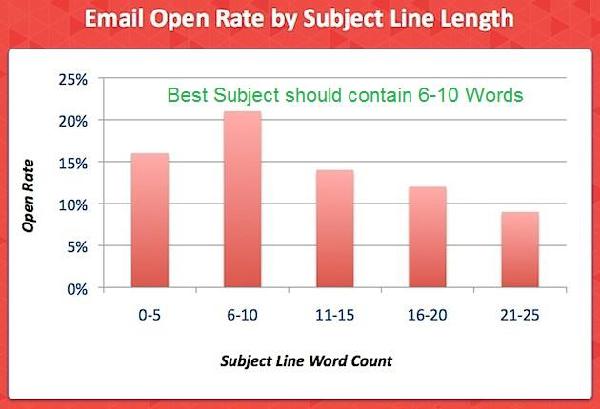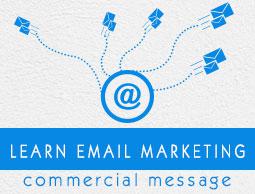Email Marketing - Content
Email Copywriting
Email marketing involves a unique form of copywriting that a lot of people, especially when just starting out, have some difficulty planning and executing. There are many similarities with other forms of copywriting, but there are also some unique opportunities and pitfalls as well. These articles will examine some of the elements of writing for email marketing and walk you through the basic steps of crafting your message.
How to Write Subject Lines?
The subject line of your email is the hook that draws your subscriber to open your email. Whatever extraordinary performance you have done while writing your email, that all will go waste if you do not choose the apt subject line for the email. Write a line that is catchy as well as personalized. Remember not to exceed more than 10 words. See the research below.

The Importance of the “From” Address
The “From” address is vital for email marketing to succeed as a form of communication. Most people will not open an email unless they recognize the “from address”. If you are sending email to the people, who know you by name send them with your personal email rather than sending from "no-reply, info, and newsletter" etc.
Making Email Content Relevant
Consider the success of blogs, forums and social networks. Those interactive channels are effective because users feel involved and engaged. Build off that premise with email copywriting by keeping the subscribers engaged and making them a part of the content.
You can consider including the following −
- Reader polls
- Reader case studies
- Q&As with customers
- User-generated content
Writing a Call to Action in Your Email
Your subscriber needs to know why you are sending them an email. This reason should lead them to a clear call to action. This CTA defines the action your subscriber is to take after they open up your email. With too many CTA’s, email marketers run the risk of confusing or overwhelming subscribers. When customers are presented too many options, they may be less likely to purchase. Instead, focus your calls to action and limit the effort it takes to act.
You can consider these quick tips −
- Rely on size and placement position to emphasize the call to action.
- Write call to action copy that tells subscribers exactly what they can expect.
- Use copy that reinforces to subscribers that taking action will be quick and easy.

Personalized Emails
So what are Personalized Emails? Have any Idea... No?
Alright give me a chance to characterize you in a short story.
Have you ever walked into your favorite store or restaurant and a member of the staff immediately recognized you? Imagine they said something like “Hey Sofia, we just got in a great hat that will go with the coat you bought last month!”
It would be a pretty surprising feeling, right?
We’re used to wandering anonymously through the world. However, if we’re offered useful information based on our likes, well that would be pretty handy. A study says that personalized emails had 29% higher open rates and 41% higher click rates than emails without any personalization. Sending a highly targeted, well-personalized email can increase your opens and clicks, drive conversion rates higher, and deliver some serious value to your users. As far as my experience is concerned, I usually get much more response, open rate, click rate with personalized message. Here are some examples to show you personalization in email marketing.

Personalizing Subject Line − As I discussed in the previous topic “Email Copywriting” that a catchy and personalized subject is all you have to write for a successful Email. You might have opened those unknown emails that include your name in subject line. Haven’t you? For a personalized email, write the name of subscriber or anything that catches attention.
Formula of KISS-Keep it Simple, Stupid
It is an important reminder for you not to confuse your clients and prospects with complicated features in your products and services. Remember, you are not selling a scientific theory to Professors, lawyers, or doctors. Even for them, they expect something simple and easy from you. Do not talk to your prospects as if you are presenting your PHD thesis to a group of Harvard professors.
Always remember, your prospects are normal people. Marketing simply means to let people know how you can solve their problems by using your product and services. Do not over-use words and grammars. You don’t have to let the others know that you know the longest words in the world, or you use correct grammar such as proverb, past continuous etc.

Effective Email Signature
Your email signature is often one of the final points of communication, a consumer has with your service/brand. A good email signature is simple, informative, professional, and puts the information in the forefront. But, this doesn’t mean your signature has to look dull or boring. There are many ways to get the most out of your email signature, so let’s run over 12 easy tips and look at some beautiful examples.
- Don’t Include Too Much Information.
- Keep Your Color Palette Small.
- Keep Your Font Palette Even Smaller.
- Give your email signature format some style.
- Add your company logo/photo to your email signature.
- Always use the ALT tag, when adding an image to your signature.
- Make it Mobile friendly.
- Make sure contact details are up to date.
- Use Social Media Icons to Drive Traffic.
- Use a different email signature for your replies and forwards.
- Give your email signature format as much thought as a marketing campaign.
- Add your latest marketing content to your email signature.
What do you think about the signature below, does it look appealing?









